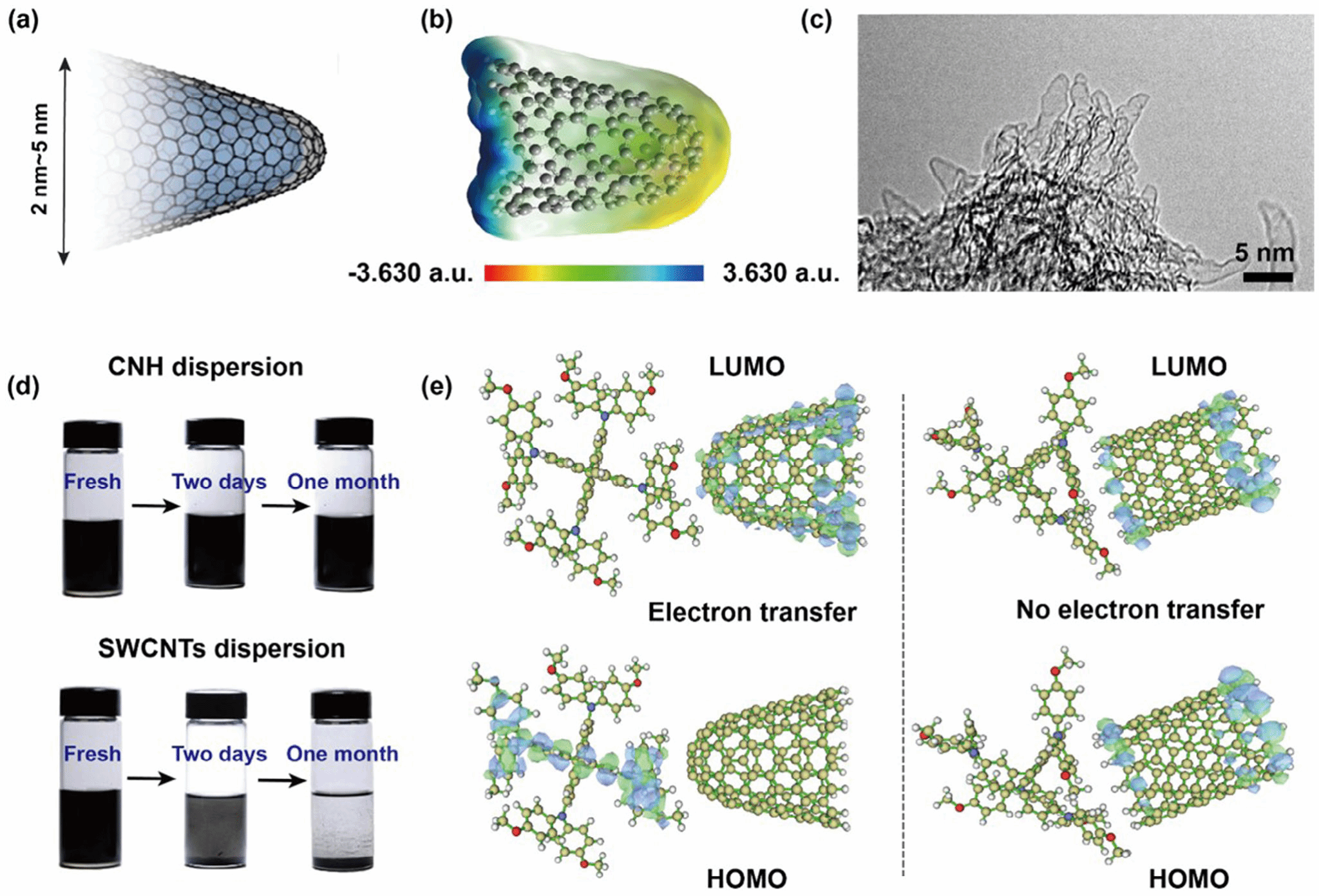Perovskite solar cells (PSCs) have emerged as a major research focus in the field of renewable energy due to their outstanding power conversion efficiency (PCE) and low-cost advantages. The doping level of the hole transport layer (HTL) material Spiro-OMeTAD critically determines the performance and stability of PSCs. However, conventional oxygen-driven doping processes are limited by insufficient and randomly distributed oxygen adsorption, hindering further improvements in PSC performance.
Recently, the research teams led by Shi Yantao and Wang Yudi proposed an innovative doping strategy: leveraging structurally asymmetrical carbon nanohorns (CNHs) to enhance oxidative doping in Spiro-OMeTAD. The polarized surfaces of CNHs facilitate uniform dispersion in Spiro-OMeTAD solutions and promote interfacial electron transfer, significantly boosting the doping process and PSC performance (Fig. 1).

Fig. 1. Charge distribution, morphology, and dispersibility of CNHs
a) Structure of a single CNH, b) Charge distribution mapping, c) TEM image (scale bar: 5 nm), d) Dispersion of carbon materials in chlorobenzene, e) Charge transfer between CNH/Spiro-OMeTAD (left) vs. SWCNT/Spiro-OMeTAD (right).
CNHs act as nano-confined reactors, locally enriching reactive species (Spiro-OMeTAD, LiTFSI, and O₂) to accelerate doping kinetics. Additionally, CNHs improve the hydrophobicity and oxygen-blocking capability of the Spiro-OMeTAD layer, thereby enhancing long-term device stability (Fig. 2).

Fig. 2. Role of CNHs in Spiro-OMeTAD films
a) UV-Vis spectra, b) ESR signals, c) XPS of oxidation products, d) TOF-SIMS after thermal aging, e) 2D TOF-SIMS mapping, f) Water contact angles, g) Oxygen transmission rates (OTR), h-i) Schematic of CNH mechanisms in HTL.
CNHs optimize Spiro-OMeTAD film morphology, ensuring higher compactness and uniformity, which enhances hole mobility and conductivity. UPS analysis confirms improved energy-level alignment at perovskite/HTL/carbon electrode interfaces, while steady-state PL imaging shows suppressed carrier recombination (Fig. 3).

Fig. 3. Optoelectronic properties of Spiro/CNH
a-c) Cross-sectional SEM (scale: 1 μm), d) Field-dependent hole mobility, e) C-AFM images (scale: 2 μm), g) UPS spectra, h-i) PL mapping (scale: 1 μm).
By integrating CNHs, the device achieved a record PCE of 23.24% (vs. 18.96% for the control) with superior stability—retaining 95.3% of initial PCE after 1,500 hours of continuous illumination, far outperforming the reference device (82.6%) (Fig. 4).

Fig. 4. Device performance of C-PSCs
a) Schematic structure, b) PCE statistics, c) J-V curves, d) MPP tracking, e) Long-term operational stability under 1-sun illumination (N₂ atmosphere, 30°C).
This study, titled "Boosting Spiro-OMeTAD Doping via Structurally Asymmetrical Nanohorns for High-Performance Carbon-Based Perovskite Solar Cells," was published in Advanced Energy Materials. Yanying Shi (Ph.D. candidate, DUT) and Guanghao Meng (Yunnan Normal University) are co-first authors, with Prof. Shi Yantao and Assoc. Prof. Wang Yudi as corresponding authors. Supported by the NSFC, State Key Lab of Fine Chemicals, and DUT School of Chemistry.
Full paper: https://doi.org/10.1002/aenm.202405355

